Lemay Ferry (MO-267) Is A Pedestrian Nightmare
Yesterday I posted about the horrible pedestrian environment along the #12 MetroBus route in St. Clair County. I took that bus on Wednesday the 16th. That night, Fox2 ran a related story (Disabled man hit 3 times on Lemay Ferry, due to lack of sidewalks):
Tony Berding says he’s been hit 3 times by vehicles on Lemay Ferry. Berding is disabled, and lives in a senior apartment complex in the 3600 block Lemay Ferry Road in South St. Louis County. He uses a motorized wheelchair to travel to a nearby Quick Trip and Kmart.
Berding was struck last Thursday while traveling on a narrow shoulder along northbound Lemay Ferry.
That evening a reader messaged me about the story, but I didn’t have time to watch. The next morning I got a message from Berding’s sister, so I watched — horrified watching her brother use the narrow shoulder to get to the store. We messaged via Facebook, then text, and finally on the phone. This is about real people at risk because of how we have chosen to build our physical environment.
Lemay Ferry in South St. Louis County is far more urban than the area I traveled through in St. Clair County, I’ve taken the #73 MetroBus numerous times, most recently the morning of August 25, 2015:
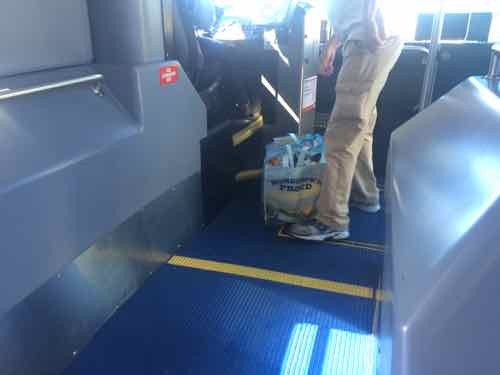
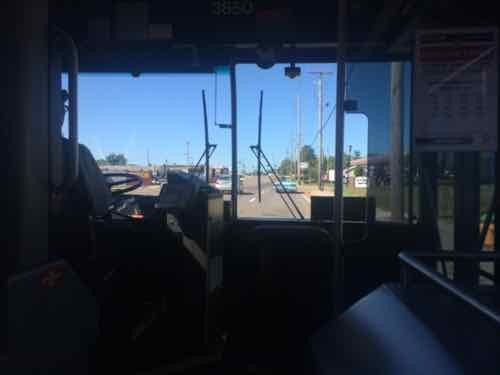
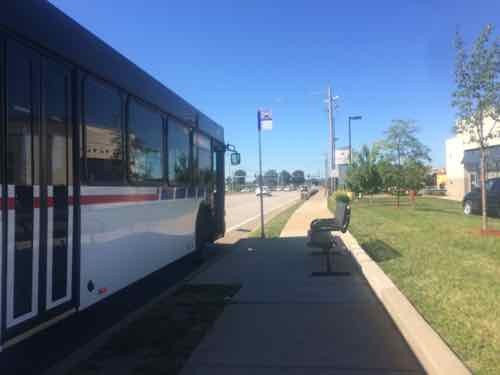
What I hadn’t done is roll along the part of Lemay Ferry mention in the Fox2 story. After looking at it on Google Street View I saw just how physically impossible the West side of Lemay Ferry was, the East side isn’t great — but it’s passable. I decided I’d have to drive to photograph. Before doing so I did some research.
Fox2 said St. Louis County indicated they couldn’t afford to buy land for the right-of-way to build a sidewalk on the East side. Two problems here: Lemay Ferry is also known as MO-267 — it’s maintained by MoDOT, not the county. Secondly, the right-of-way is 80 feet wide — more than enough width for four travel lanes, a center turn lane, and sidewalks on each side! More on this later, let’s take a look at the problem.
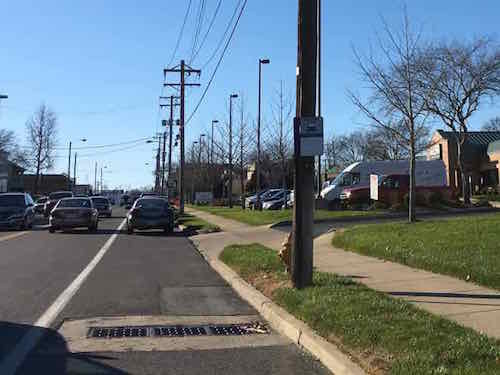
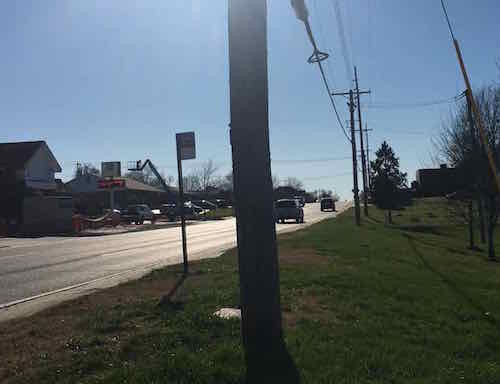
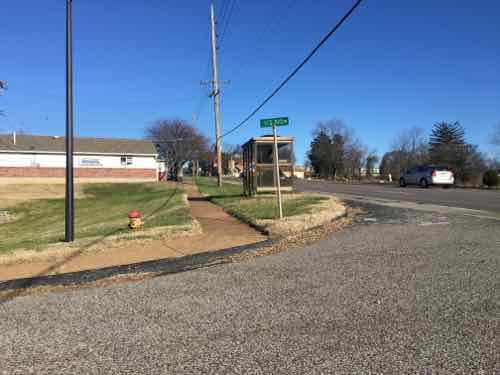
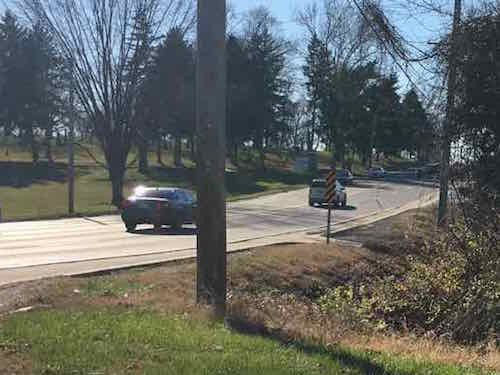
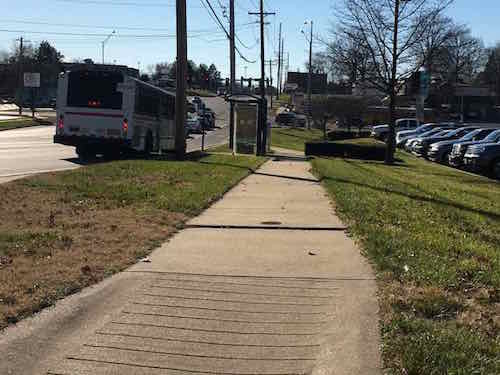
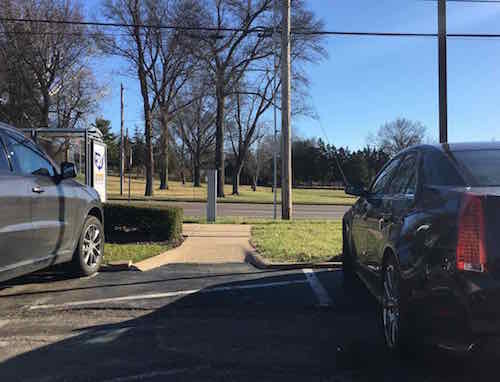
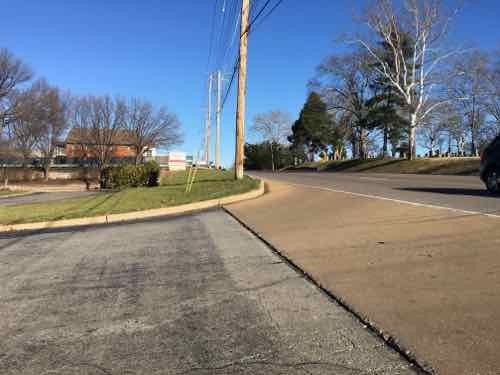
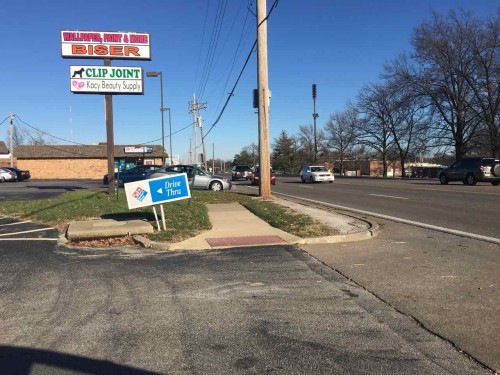
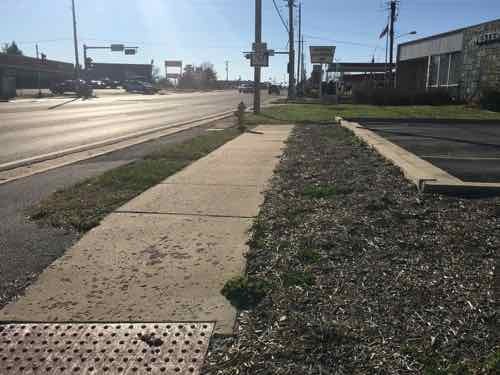
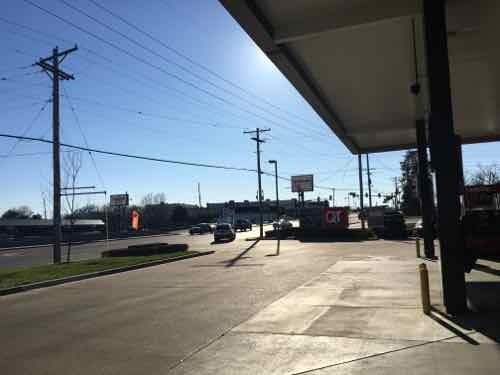
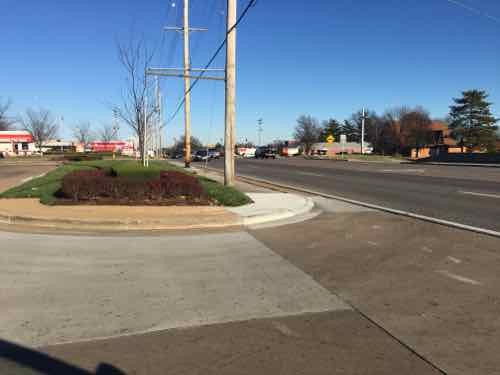
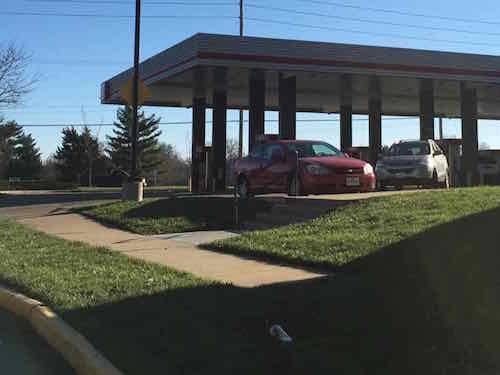
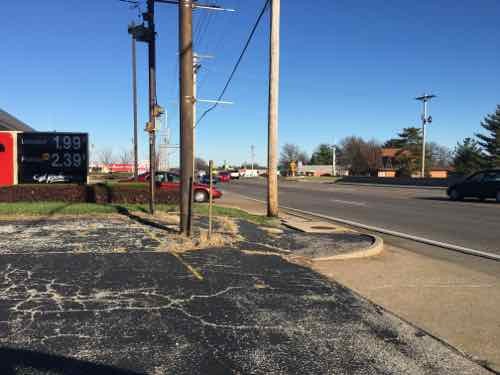
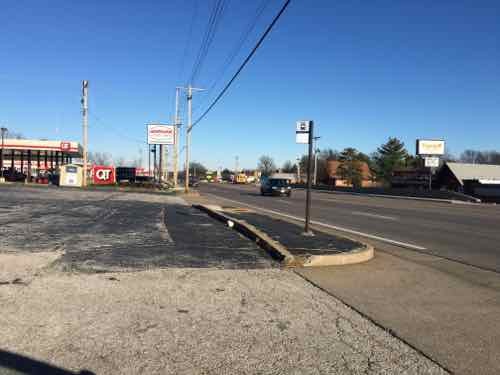
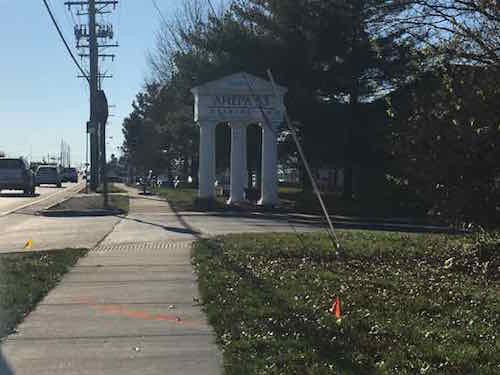
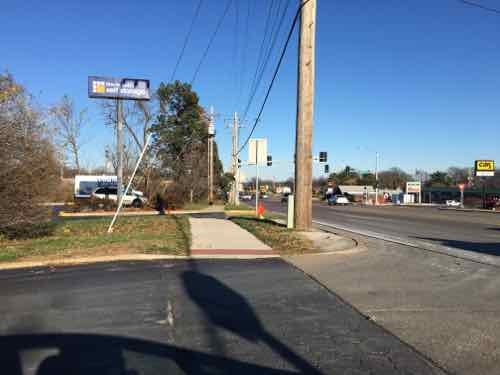
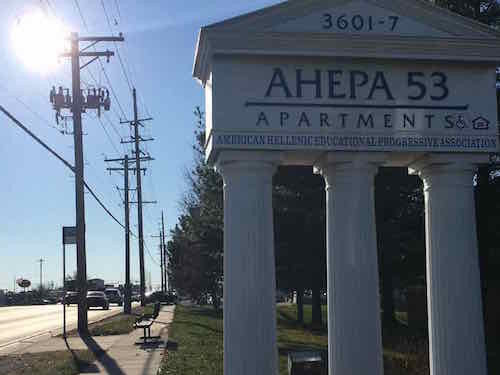
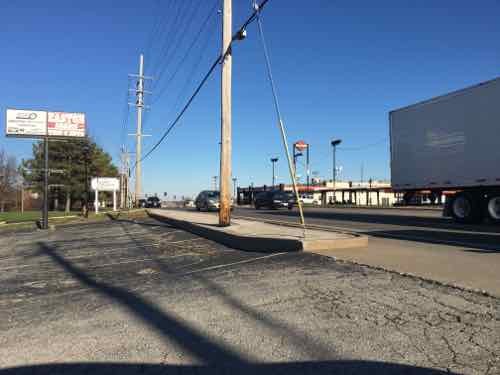
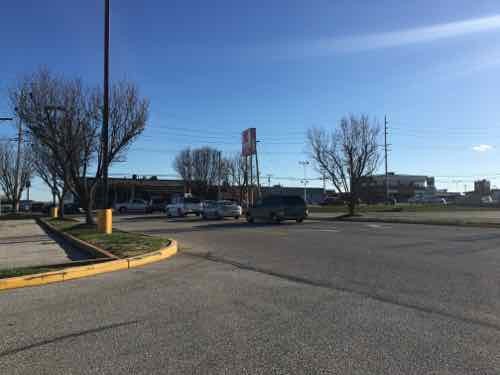
So why not just move? When you’re disabled and low-income housing options are very limited. It has been 25 years since the Americans with Disabilities Act became law — St. Louis County & the Missouri Dept of Transportation need to prioritize this.
Below are two examples of dividing the existing 80′ right-of-way so still have four drives lanes & a center turn lane.
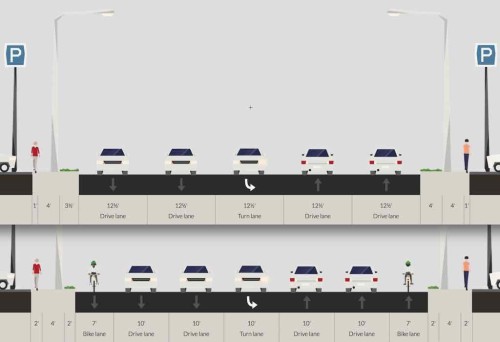
My guess is decades ago Lemay Ferry was a 2-lane road that got widened after people & businesses began moving to south county from south city. It went from a rural 2-lane to a 4-lane with center turn without any consideration for pedestrians. The 80′ right-of-way might have been in anticipation on more lanes of traffic — the land was subdivided before I-55 was even a dream.But MO-267, aka Lemay Ferry, is used by pedestrians. People use transit. Not all residents own cars.
It hasn’t kept up, but it needs to change. Before someone gets killed!
— Steve Patterson
I agree, this not good for pedestrians – now, how do we get things changed? Bottom line, it needs to be a political decision, something that one or more politician makes a priority, like Stenger is doing with the Police or Ogilvie is doing with bikes. MoDOT has been doing some work on some state highways, but most of the real problem areas are in the inner-ring suburbs, where most of the neighborhoods are “mature” and there is little reconstruction of the infrastructure happening. These problems have been around for decades, and most of the adjacent property owners a) don’t want to spend the money, b) don’t have the money to spend, c) don’t want to pay higher taxes, d) don’t want to establish a special taxing district, and e) don’t want the county (or whatever small city they live in) tearing up their yards!
I’ve lived places where curb ramps and sidewalks have been installed / retrofitted on a systematic basis. It takes a lot of work, it’s not easy. It takes pushing to make it a recurring budget item every year. It takes contracting for x number of ramps every year, attacking one area at a time, and getting it done. It takes making correct access, with proper sidewalks and proper ramps, a required part of ANY new project – no exceptions, no waivers, no excuses. It takes changing the community mindset and it takes strong leadership, from advocates on both the funding side (city/county council) and on the implementation side (public works/streets/highways). And, unfortunately, making it a priority because it helps the disabled really is not all that important. Making it a priority because of moms and strollers, people walking their dogs, kids riding their bikes and elderly people getting their daily exercise, safely, resonates more with the vast majority of voters. Bottom line, the best way to make this happen is to pass a bond issue dedicated to improving both sidewalks and trails, on a countywide basis. But the challenge remains a fractured political system, both geographically and functionally, since no “city” is going to spend money outside their little fiefdom, and most are going to have a problem with the county messing with their local au-thor-i-tay!
The problem is the lack of design consideration for all pedestrians, including ADA. The abandonment of pedestrian approaches as the basis for city design is the norm in St. Louis, as a result transit has too been severely weaken.
This is not to say the auto is not important, but there is absolutely no balance. Because of my daughter I went to the Galleria and the nearby Target/Trader Joe’s complex. Quite simply it was, as always, only worse, a clusterfuck of automobiles. It was almost hilarious watching everyone trudge from the auto across the lot to various stores, It would be funny if it wasn’t a sad commentary on how St. Louisians live their lives. Search for a parking space, walking past car after car to get to your destination, trudging back.
The transit station located in this area is absurdly cut off from commercial contact for the most part, even with recent improvements. In fact the ability of transit to feed commercial areas is almost completely ignored throughout the region.
This is what passes for the norm in St. Louis.
Technically you’re right, the job to make streets and sidewalks passable throughout the region is no small one, even with the increased awareness and progress in recent years.
Still the underlying fault is the very way urban planning is approached, leaving pedestrian/ADA situations like this as examples of failure. Bond issues are a tool, but all the bond issues in the world aren’t going to accomplish a thing if clear approaches to pedestrian success are not followed and made a priority. That means more than a few curb cuts and sidewalks.
The city should be designed for human beings, not cars, it is humans using the city.
Yeah, yeah, yeah – so how do we convince people in this region to spend $100 million on pedestrian infrastructure and better planning instead of a new stadium or more tax breaks for existing businesses?! Yes, it IS about PRORITIES – that’s patently obvious. And pedestrians are NOT a priority – how do we evolve and change that mindset?
I wonder if the typical urban or suburban resident is really interested in improving or expanding pedestrian infrastructure, or if it is a priority only among the few whose lifestyles are served by buses, commuter trains and even taxi cabs. I wonder how many every-day-joe types are content to fight heavy traffic congestion a few times a year in exchange for the convenience and SAFETY of placing their purchases in their cars and driving directly back to their homes–not having to deal with the inconveniences of public transportation or walking/biking to get their errands done. Negotiating through traffic congestion is just a part of life–much like receiving an injection before having a cavity filled, surviving the preparation before a colonoscopy, dealing with the anxiety of the long drive to your kid’s school when you’ve been informed that he’s been suspended and is sitting on the bench outside the principal’s office, waiting. I personally don’t want to deal with public transportation any more than I already do. I like to get my business done and go on with my life on my own terms and at my own pace. And if I never see the inside of another taxi or commuter train, I won’t feel deprived of anything. Merry Christmas to all! (sitting in a Mobile airport waiting for the inclement weather to pass so that I can get home for the holidays)
And Merry Christmas to you and all, stay safe traveling.
The first part of changing that mindset is to talk about the subject like what is happening here. Most people are never exposed to any or minimal discussions about architecture and urban design throughout their whole education, which is pretty astounding considering we live daily in the results.
Definitely broader discussions and solutions are needed. Part of the problem is the focus on the automobile is so great in the region that alternatives are not known or understood by anyone moving from place to place. Certainly the experience of successful transit as a viable alternative and not simply a path of last resort is impossible unless St. Louisians visit other cities.
There are many policy changes that can occur without spending tax money.
Simply identifying priority pedestrian districts and making any new development conform to pedestrian needs would be a start. (Which more or less dovetail to transit needs)
Selling ideas to the public has to show how it benefits everyone to take action. With global warming concerns on the forefront, I believe many would listen to reasonable proposals that can also boost the quality of life.
But you are right, that is the key question, how do we evolve and change that mindset? Certainly public nonprofits like Citizens for Modern Transit and government representatives at East West Gateway and Metro aren’t doing the job.
The thing is, if change doesn’t happen sooner rather than later, I believe we will eventually be forced into action, a less desirable outcome.
Finally getting back to curb cuts, it isn’t going to help much to spend the money on them if it isn’t backed with policies that support a pedestrian orientated environment, otherwise all we will end up with is a bunch of curb cuts nobody uses.
Ultimately there are many design problems involved, for instance there are sidewalks along Manchester in the Ballwin area, but no one uses them. What should commercial, auto, pedestrian and transit environments look like and how can these uses be reconciled in this area? Staging architectural competitions is a good way look at urban design concerns and another way to evolve.
My decisions to use mass-transit vs personal vehicle varies depending on the city I’m visiting. When I’m in Dallas, I avoid driving at all costs. Dallas drivers are the very worst, in my opinion. Their light-rail system serves the city well, and there are plenty of shuttles and taxis to complete the commute. Plus there’s a heavy presence of police and transit guards. The entire city of Dallas appears to be well-served by their mass-transit system. So, for now, I use mass-transit when I’m in Dallas. But if Dallas drivers ever learn not to tailgate and randomly switch lanes at 75 MPH, I’ll be the first to seek out a rental car. While Los Angeles has an incredible and very comprehensive subway/light rail/bus and shuttle system (with noticeable police and transit guards), I prefer to rent a car there, avoid the freeways during the busy hours, and negotiate my way around town using major E/W arteries and side streets. But for someone less familiar with LA, their mass-transit system might be a good choice because it is well-planned and serves the entire city. St Louis’ doesn’t. The absence of service to the entire southern and western sections of STL is a killer, and so those commuters are forced to complete their commute on a bus or by using a personal vehicle–which sorta defeats the purpose of using mass-transit to begin with. Some businesses in other cities offer private bus service to complete the commute. My kids travel daily by high-speed rail from Frankfurt to Cologne to attend school. The commute takes a little over 1 hr each way. When they arrive at the station in Cologne, the school meets them with a shuttle bus. In Frankfurt, a taxi-stand is within 100′ of the station. Police presence is THICK! Without these accommodation, I’d be reluctant to use mass-trasnsit–especially to send an 8 year old 100 miles away to school on a train, even in the presence of his two older brothers. Factories and businesses all over Europe do the same thing and provide private shuttle services to accommodate their employees using mass-transit. When I’m in Atlanta, I avoid their mass transit entirely. I have found it to be filthy, unsafe, unguarded and ill-conceived. I’d rather walk. In my hometown of Baldwin County (in Alabama, which extends from Bay Minette south to Gulf Shores), their not-so-rapid bus system will pick you up at your home and take you to the threshold of your destination ANYWHERE in the entire county, for a fee which varies between $5.00 to $7.50 per trip, less for a round-trip fare!! Not bad for back-woods Alabama! I think if STL’s mass-transit system is ever going to succeed, it’s going to have to bite the bullet and expand to the south and west; it’s going to have to increase its police/security presence; and its got to do something to enforce its rules and regulations–even if to do so appears to be counter-cultural. And no one wants to be waiting on a dark street corner to transfer to a bus in order to complete the commute. That process has to be streamlined to make it safer, less complicated, more comfortable, more consistent and more reliable. (There’s comfort in knowing, though, that I personally have control over my own transportation needs. If I could sail a boat, I wouldn’t be still waiting in Mobile for the next flight to JFK.)
Thanks for your perspective of how you view other cities, very informative. I guess my take on cities I visit is similar, ie judging transit vs auto and so on, but you offer some good insights.
My daughter may attend college in LA so I have looked at LA transit maps recently and was surprised to see the were far more organized and had a seemingly easy to use transit system compared to St. Louis, you haven’t completely confirmed that, but almost. An interesting perspective nonetheless.
Plus if you pair Dallas with LA, cities with heavy sprawl it is a good indication how badly St. Louis is failing, maybe the sprawl is even more disconnected in St. Louis, or is it the organization of transit?, not completely sure.
I know what you mean about a lack of service in many St. Louis neighborhoods, the real proof of the pudding on that is the 2000 plus commuter lot at Hanley Rd and Hwy 270 for Metrolink and various bus connections. Clearly if someone is willing to drive their car to the commuter lot they would likely be willing to take a bus or transit from near their home. So again the failure is either urban planning or transit, or both. Cities with the most successful transit have either no commuter parking or only small areas.
I wrote Helsinki City Planning recently and I asked them what percent of people took transit and how much parking around Olympic Stadium? It is around the size of our Busch Stadium. They replied they had 1850 spaces, or the approximate size of one garage near Busch. The Finnish engineer then responded that he wasn’t sure of the percentage of people that used transit, but that almost everyone had to take transit, walk or use bicycle since there were so few parking spaces. (Again note, there are more parking spaces at Hanley Rd, transit, Metro stop also).
Plus you are right security is important, however I think security is easier to attain when all of society has a vested interest in successful movement systems, not just those left out of mainstream society.
While both LA and Dallas have a huge amount of sprawl, they also have central business districts that are doing far better than St. Louis’. They also have a much more “organized”, grid-based, surface street system, which makes it easier to implement a grid-based (as opposed to radial) bus/transit system. Finally, even though they have multiple suburban “cities”, overall, they are far less fractured, politically, than the St. Louis region. Both Metro, in LA, and DART, in Dallas, are well-funded, on a regional basis, so they’re able to and motivated to deliver service across their respective regions. Add in that LA, even though it sprawls, is also suprisingly dense, denser than Toronto, New York or San Francisco: http://www.citymayors.com/statistics/largest-cities-density-125.html
Interesting analysis, although I’m not sure how the fractured politically fits in. The transit decisions and what to pursue are primarily Metro itself and East West Gateway Council, I personally think it is poor decision making by those institutions that fail to present a plan with reasonable outcomes the public can by into.
Their St. Louis Connected 2045 (http://www.ewgateway.org/trans/longrgplan/2015/Connected2045.pdf)
car and transit plan pretty well offers nothing for transit, other than hoping (hoping) they can fund rail lines that have already proposed for years. There is the usual compliment of pretty words though as if bicycles, pedestrians or transit where a real priority. I hate to be so cynical, but we are living with the results as Steve’s blog post suggests
How to build a proper transit system and make it work isn’t even on the radar of these two institutions, plus MoDot.
St Louis, at least the city and a portion of the early suburbs have good bones that will support transit if the decision making to utilize those advantages are made. There is a grid based core as in LA and Dallas that in turn supports a vibrant downtown. The far suburbs of St. Louis are no doubt a special problem at this point. It is going to take some creative thinking to make transit work throughout the region.
Then we have the chicken and egg problem, which comes first a bustling downtown or transit? I think you have to have some idea how transit, pedestrians will work with the auto to proceed with physical planning, location of parking etc. Given the random nature of the city planning in downtown St. Louis clearly no thought is given to an integrated urban experience, hence a dead downtown.
In other words what in the decision making is causing St. Louis to fail to match successes of say LA and Dallas as a urban environment?
I have mentioned a few institutions above, you could probably add St. Louis city planning and then county planning also.
This is where the fractured political landscape fails in my view, at the juncture of city planning and transit planning (I am not saying this is the only fracture point in the many muni approach to governing, justice and policing being the most obvious shortfalls that have appeared in recent months)
Nobody in the public is ever going to vote for transit funding in St. Louis if the only proposal, by the regional transit planning agency (see Connected 2040 St. Louis above) is half ass.
The way fractured politically fits in is a) the last thing to get cut from any government budget is employees, especially at the upper levels, and b) whether it’s transit or sidewalks, any transportation system is only as strong as its weakest (missing) links. This region continues to pay the salaries of 150, or so, mayors, 40-50 fire chiefs, 100, or so, police chiefs and several dozen school superintendents. Besides being inefficient, it’s a drain on the tax base. It’s money spent on people doing “something” instead of actually delivering services like better infrastructure. And because every poltical entity budgets independently, there will always be gaps in service and infrastructure, as you travel from city to city to county to city to city to county to anaother county . . .
I’ll repeat, if you/I/we/Steve want better sidewalks, better transit, better access for people with disabilities or better bike facilities, it’s going to take having champions for those causes in positions of power in government, people like Scot Ogilvie. We continue to grow the regional trail system (whether we need it or not) because Trailnet and Great Rivers Greenway have made a case for doing so and have succeeded in getting secure, substantial, funding to implement a well-reasoned, regional plan. The same goes for Forest Park and Forest Park Forever. The Regional Transportation District, in Denver, includes all 8 counties in the region, is regionally funded, with dedicated taxes, and delivers services to all parts of the region. It’s run by an independently elected board, responsible only to the citizens. It’s not an appointed board, like Metro has here, where the unknown board members are only responsible to the handful of politicians who put them in their positions.
MODOT has made pleading poverty into an art form, and with good reason. With low funding levels and high, and increasing, demands, yes, they ARE poor. They’re not financially able to do much more than put patches on what they have now. “Frills”, like new sidewalks and diverting state funds to urban transit systems, simply are not priorities, for very valid financial reasons. Bottom line, we get what we pay for . . . and, at this point, it looks like it’s going to be a shiny new football stadium!
I’ve been wondering if a solid lawsuit can be formed arguing that sidewalks are mandatory where-ever cars are allowed to go faster than, say, 20 mph. The argument goes like this.
The right to walk on the “public highway” dates back to the Roman period and is an uncontested part of common law — a *right*. There is, however, no such right to drive a car. Allowing cars to go at speeds which make it dangerous for pedestrians to walk on the public highway constitutes a hazard *created by the city* for which the city is liable — unless the city provides sidewalks. The city’s choices are: provide sidewalks; or close the road to cars.
The courts may not yet be ready for this argument. But I think it’s legally correct. It’s got to be possible to build up some preliminary, smaller cases…
Combine it with cities ignoring the ADA’s mandates and you might have a viable case . . . and having courts mandate improvements is one of the few ways things will ever change, absent any elected champions!
Go for it, counselor! Sounds good enough for me to vote yes, right now.
It’s fairly obvious that the law school you attended taught a course called “symbolic logic”, a logic based on mathematical formulas, postulates and syllogisms. Am I right? (Modus ponens, Modus Pollens, etc?)
If your daughter is considering attending college in LA (great choice), I assume she plans to attend either UCLA or U$C or Pepperdine (all excellent choices). The main UCLA campus, being tucked in between Beverly Hills and Brentwood, is generally very safe and accessible to an extensive bus network. Owning or operating a car would be a nuisance. My wife did her residency at UCLA’s Ronald Regan Med Ctr, and never encountered even a single unsavory or threatening incident in her daily commutes between the hospital and Santa Monica. U$C is located closer to downtown LA, and while the area (outside the campus proper) in general sees more crime than in Brentwood, the campus itself is extremely well patrolled with few reported crime incidents. Both bus and train service are very convenient. Some of their students park their BMWs and Mercedes on campus, but few frequently use them. Pepperdine’$ campus is pri$tine, less acce$$ible to public transportation other than bus service, but few if any of their students would probably consider using public transportation even if it pulled up to the front door of their dorm $uites. East of UCLA, LA’s mass transit system is well-planned, very safe with noticeable sheriff and transit police presence, and always on-schedule. West of UCLA is served mostly by bus, and few if any residents (other than students) would consider using it anyway.
Thanks for the info, it’s useful to get your perspective. I have only been to LA airport a few times for connecting flights, I never really had a chance to took a look at the city. My daughter wants to study acting and so she has also applied to conservatories in LA. She just went out to LA with my son and his wife a month or so ago and did some auditions, visited schools and appeared in LA’s forty eight hour film project. She also has other school auditions in Chicago in February. I know public transportation can be a hard sell unless it is a city like New York. I’m trying to teach her how to live like a bohemian and to focus on her goals. I just think a car can be more of a distraction than helpful, especially for students.
And in fact, if everything else was equal, New York would have a clear edge because of the transit system.
Students in LA have no use for a car. Excessive on-campus parking fees and event parking fees at venues around the city convince most students that operating a car there isn’t worth the convenience. And if she lives off-campus, there may not be any street or lot parking available in her neighborhood, no matter how much $ she can throw at the local parking czars. Actually, if she attends school around UCLA and lives in West Hollywood, she can enjoy a Sunday afternoon at the beach in Malibu, Santa Monica or Venice quicker using the city bus service than if she would drive, and she’ll avoid the strictly-enforced $35.00/4-hr parking fee around the beach–if any spaces are even available.
In LA, if you’re ever in a raging hurry to get to an audition and the bus/subway system doesn’t work, there are always *lots* of taxis. Really no reason to own a car.
The clusterfuck you describe was made that way with the New 64 which Patterson lovingly wrote about. Now cars traveling across Hanley & Brentwood Blvd are traveling over 60 mph as the ramps were made like highways.
Just to the north of Dierbergs, TJs, etc are over 150 homes just 500 feet away. However the New 64 removed a pedestrian bridge over 170 and failed to allow pedestrian access over the New 64. Thus a 500 foot trip to TJs requires walking 3.6 miles round trip.
Look it up on Google maps – thanks to MoDOT and Hoffarth.
The should just get rid of the suicide lane and use the space for sidewalks. All it would take is a bucket of paint and a few bollards to make the change. That and the political will.
Nope – wrong answer. And not because it would create more inconvenience for drivers, but it would essentially mean, literally, “kicking pedestrians to the curb”. It would also end up being just another exmple of “doing things on the cheap”. Sidewalks are not that expensive (probably less than repaving a lane on the street), and doing things right just takes motivation, political will. The problem is they simply aren’t sexy, not like new gateways into Forest Park, a new library or a new stadium.
The problem in America in general and in St. Louis in particular is that after decades of poor urban planning, cities and state DOTs have no money left to do anything except “on the cheap”. Sidewalks are cheap, but renaming streets sidewalks are even cheaper.
I have to disagree. If we can decide to spend more than a billion dollars on a cathedral to the NFL, aka the “new stadium”, we can also decide to spend HALF that on improving our pedestrian infrastructure. It’s just, as a community, we CHOOSE not to, not to make it a priority! There are plenty of new subdivisions going in, in surrounding counties, aka “poor urban planning”, that do include sidewalks, and MoDOT is finally doing something, after decades of doing far less. It’s the “established” (fading? stagnant?) communities that seem to be doing little or nothing . . .
Obviously public money shouldn’t be wasted on the NFL, You’re preaching to the choir on that one 🙂
Meanwhile, in Denver, newly-elected “Paul Kashmann, Denver City Councilman District 6, “is spearheading a council group that’s looking at citywide sidewalk needs and how officials decide where to install them.” Show your support for sidewalks by signing WalkDenver’s petition at http://www.walkdenver.org“
This is a consistent problem on MoDOT roads all over South County. Many of them have asphalt ‘aprons’ which are a poorly shared space for pedestrians and parked cars, with no curb cuts anywhere in sight. This works ok for the able-bodied, but it’s a disaster for anyone using a wheeled mobility device. Mackenzie, Watson, Gravois — all have similar situations. In places there may be short stretches of actual sidewalk, but like those along Lemay Ferry, they tend to be so short and disconnected they are useless.
I do have to give St. Louis County credit for one positive project on a county arterial road down south – they are installing actual sidewalks replacing a substandard apron along Morganford Road/Union Road from the St. Louis city limits south to Weber/Bayless; and upgrading existing sidewalks with ADA-compliant curb cuts from Weber/Bayless south to Reavis Barracks. That’s a significant improvement, and necessary in particular due to the lack of MetroBus service on that road, and given that there are still some children who walk to several nearby schools and school bus stops. Better sidewalks can only help improve access to education. But it’s costly — the total project including new sidewalks and roadway resurfacing is about $2.3 million.
Back when my great-grandfather had a farm on that stretch of Union Road 60 to 100 years ago, perhaps there was no need for such facilities. But today, and in the future, I’m hoping we can get more investment in pedestrian access, so that all our busy roads can be accessible and available for those of various physical capabilities and of all ages!
It’d be very interesting to know how that $2.3 million is split between repaving/apron work and actual sidewalks.
The cost of 5′ wide, +/-5″ thick, 5000 PSI sidewalks in (union) STL, double edge formed and mildly-reinforced post-formed curbing, without mesh and with minimal regrading and without significant utility relocation, typically runs between $7.50 to 9.00 per SF, depending on the scope of the job. Smaller jobs end up on the high end. Adding sidewalks along an existing roadway apron area can dramatically/adversely affect water run-off, especially at any intersections and disabled ramps, which can boost the price of road resurfacing significantly, forcing the contractor to scarify the existing asphalt surfaces for improved drainage.
Thanks for the raw data . . . so, 500′ of 5′ wide sidewalk should run less than $25,000, and a mile would cost about $250,000, and two miles on two sides would be close to $1,000,000 . . .
“…Lord willing and the creek don’t rise…” While I wouldn’t accept a contract based on the verbal sketch and on my estimate, I would be comfortable budgeting with those unit prices. And I can’t be more than 50% off.
The 80′ ROW is plenty wide but right now the roadway & apron is pushed to the West side where utility poles take up the remaining width in most places. You also need many curb ramps for the ton of auto driveways.
In the total scheme of things, the additional curb cuts aren’t a total deal breaker, since job set-up and material costs are essentially already included in the sidewalk unit price, so a ?? % labor upgrade (only) needs to be factored in, depending on the number of work interruptions you’re talking about. But all the curb cuts may (and probably do) affect drainage and therefore increase street paving (vs sidewalk) unit prices. Don’t understand your comment about the utility poles, but if they’re stuck in the middle of an area that needs to be unobstructed, then the poles will need to go…which also affects unit prices–but the presence of the poles and the number of curb cuts should have no room in a discussion about a safe unit price for new sidewalk construction .
To do it right, the entire 80′ ROW needs to be reworked, The extra shoulder needs to disappear from both d=sides. The West curb line needs to be moved 3-5′ Eastward. That said, there is likely a stop-gap way so people aren’t having to use the existing shoulder.
Sometimes (often) there’s a better value associated with reworking an entire roadway, especially when drainage challenges exist. But taxpayers don’t always agree. When in my early years I used to do civil jobs, I’d often waste hours trying to design around existing conditions, just because the client had specifically stated that “orders from above” ruled out a total rework. The results of such a directive often become points of “discussion” in blogs such as yours!
Yes, the penny-wise, dollar foolish mentality. My preference would be a complete redo of the full 80′ ROW. In the meantime, however, there are a few spots where obstructions could be removed to allow people to get through until the bigger project can be designed, funded, and built.
Yes. But when municipalities don’t find themselves standing in tall cotton, they are often forced to consider stop-gap measures to address problem/non-compliant areas, the worst result being that taxpayers later point fingers and complain when a few years later, the municipality finds the funds to do a thorough job. Taxpayers often don’t understand that money isn’t sitting on a shelf waiting to be spent (for their pet projects), and then they bitch like hell when the money is spent. Small town public city council meetings can be a hoot, much like a Sunday morning service at the Lot Road Baptist Church near my childhood home!
True. In this case the entire stretch is within unincorporated St. Louis County. This is why governments are supposed to identify these issues in their ADA Transition Plan –ranking each. As funds become available they start with the highest priorities.
…and let’s hope the fortune tellers don’t run into many unforeseen glitches along the way…!
Need a legal review on the state of ADA law related to sidewalks and bus stops. Because this looks absolutely egregious. Class action suit? Go for a permanent injunction?